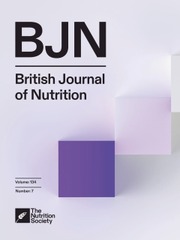No CrossRef data available.
Article contents
Dietary glycemic index and insulin index in association with incident type 2 diabetes mellitus in adults
Published online by Cambridge University Press: 10 February 2025
Abstract
There is a lack of information from Middle Eastern countries regarding diet-disease associations. We examined dietary glycemic and insulinemic potential in relation to risk of incident diabetes among a large group of Iranian adults. The present study was carried out using data from Yazd Health Study (YaHS)-Taghzieh Mardom Yazd (TAMYZ), a prospective cohort study on adults aged 20 to 70 years in Yazd Greater Area, Iran. This study was initiated in 2014-2016 (baseline examination) and data are collected prospectively at one 5-year intervals. Data on demographic characteristics, dietary intakes, and potential confounders were gathered by interview. During the follow-up phase of the study, diabetes incidence was confirmed by laboratory tests and physician diagnoses. This study included a total of 6178 participants in the cross-sectional analysis and 5105 subjects in the prospective phase. Examining the cross-sectional phase, we failed to find any significant association between dietary glycemic index (GI) and glycemic load (GL) as well as dietary insulin index (DII) or dietary insulin load (DIL) and prevalence of diabetes. No significant relationship was also seen between DII/DIL and risk of T2DM in the prospective phase; however, in the stratified analysis by BMI status, there was an inverse significant association between DII and risk of T2DM (HR for T3 vs. T1: 0.19; 95%CI: 0.04, 0.92; P=0.03) in non-obese (BMI≥25 kg/m2) and overweight (BMI<25 kg/m2)participants. No significant association was found between dietary GI/ dietary GL/ DII/ or DIL with risk of T2DM. More research, particularly with a longer follow-up duration, is needed to confirm these findings.
Keywords
- Type
- Research Article
- Information
- Copyright
- © The Authors 2025


